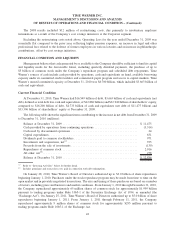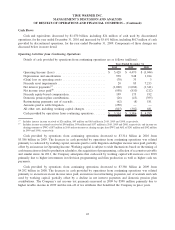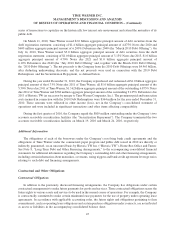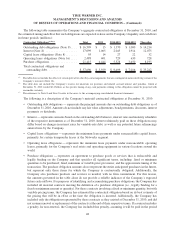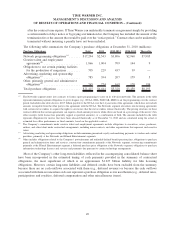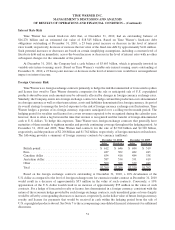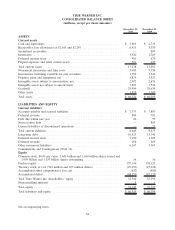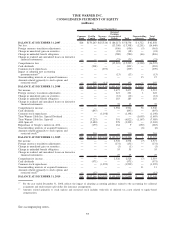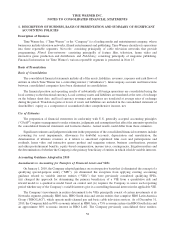Time Magazine 2010 Annual Report Download - page 64
Download and view the complete annual report
Please find page 64 of the 2010 Time Magazine annual report below. You can navigate through the pages in the report by either clicking on the pages listed below, or by using the keyword search tool below to find specific information within the annual report.Equity Risk
The Company is exposed to market risk as it relates to changes in the market value of its investments. The
Company invests in equity instruments of public and private companies for operational and strategic business
purposes. These securities are subject to significant fluctuations in fair market value due to the volatility of the stock
market and the industries in which the companies operate. At December 31, 2010, these securities, which are
classified in Investments, including available-for-sale securities in the accompanying consolidated balance sheet,
included $883 million of investments accounted for using the equity method of accounting, $313 million of cost-
method investments, primarily relating to equity interests in privately held businesses, $547 million of investments
related to the Company’s deferred compensation program and $53 million of investments in available-for-sale
securities.
The potential loss in fair value resulting from a 10% adverse change in the prices of the Company’s
available-for-sale securities would be approximately $5 million. While Time Warner has recognized all
declines that are believed to be other-than-temporary, it is reasonably possible that individual investments in
the Company’s portfolio may experience an other-than-temporary decline in value in the future if the underlying
investee company experiences poor operating results or if the U.S. equity markets experience future broad declines
in value. See Note 4 to the accompanying consolidated financial statements for additional discussion.
CRITICAL ACCOUNTING POLICIES
The Company’s consolidated financial statements are prepared in accordance with U.S. GAAP, which requires
management to make estimates, judgments and assumptions that affect the amounts reported in the consolidated
financial statements and accompanying notes. Management considers an accounting policy to be critical if it is
important to the Company’s financial condition and results of operations, and if it requires significant judgment and
estimates on the part of management in its application. The development and selection of these critical accounting
policies have been determined by the management of Time Warner and the related disclosures have been reviewed
with the Audit and Finance Committee of the Board of Directors of the Company. The Company considers policies
relating to the following matters to be critical accounting policies:
• Impairment of Goodwill and Intangible Assets;
• Multiple-Element Transactions;
• Income Taxes;
• Film Cost Recognition, Participations and Residuals and Impairments;
• Gross versus Net Revenue Recognition; and
• Sales Returns, Pricing Rebates and Uncollectible Accounts.
For a discussion of each of the Company’s critical accounting policies, including information and analysis of
estimates and assumptions involved in their application, and other significant accounting policies, see Note 1 to the
accompanying consolidated financial statements.
CAUTION CONCERNING FORWARD-LOOKING STATEMENTS
This report contains “forward-looking statements” within the meaning of the Private Securities Litigation
Reform Act of 1995. These statements can be identified by the fact that they do not relate strictly to historical or
current facts. Forward-looking statements often include words such as “anticipates,” “estimates,” “expects,”
“projects,” “intends,” “plans,” “believes” and words and terms of similar substance in connection with
discussions of future operating or financial performance. Examples of forward-looking statements in this report
include, but are not limited to, statements regarding the adequacy of the Company’s liquidity to meet its needs for
the foreseeable future, the impact of plan amendments on employee benefit plan expenses, the Company’s
international expansion plans, the impact of increased programming costs associated with Turner’s investment in
NCAATournament Games programming, the impact of the timing of theatrical and home video releases, future film
licensing obligations and the impact of increases in cash used by working capital.
52
TIME WARNER INC.
MANAGEMENT’S DISCUSSION AND ANALYSIS
OF RESULTS OF OPERATIONS AND FINANCIAL CONDITION – (Continued)


